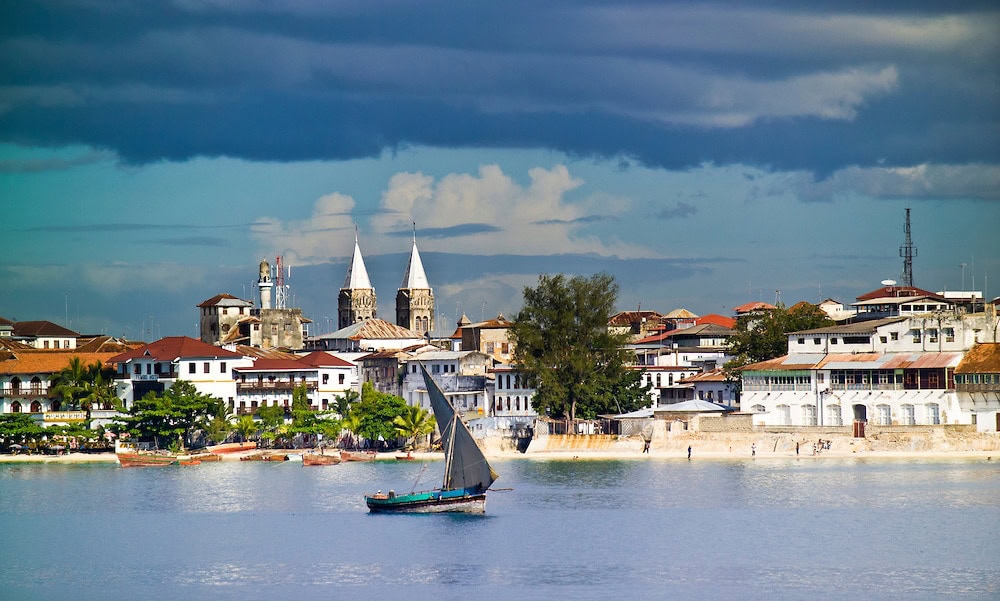Stone Town is Zanzibar’s historic heart, a bewildering maze of streets and alleyways that form the westernmost tip of Zanzibar Town.
These days, the island’s bustling capital is home to some quarter of a million people, but lost in the tangle of Stone Town’s narrow streets, it’s easy to imagine yourself floating back in time.
Twisting passages unfurl beneath delicate balconies as you dodge clattering coffee carts and slip by past ornately carved doors.
At three and four stories, the buildings tower overhead, leaving just a ribbon of sky between billowing laundry and shutters flung wide.
Though first settled by the Portuguese in the 16th century, most of Stone Town’s construction dates to the 19th and (to a lesser extent) 18th centuries – a mesmerizing mix of Arabic, Persian, Indian and British architecture.

Victorian-era accounts of the quarter carry an authentic feeling to this today. Stone Town is a perfect holiday destination in Zanzibar if you want a cultural and historical experience.
Highlights of Stone Town
- Walk the streets: The best way to explore Stone Town is on foot, though renting a bicycle is an option if time is short. Hiring a local guide is a great way to discover the hidden histories and lesser-known sights, and the end of Ramadan is especially festive, with lanterns lining the alleys and a feast of street food on every corner.
- Go shopping: From neat, sustainable fashion boutiques to the loud, chaotic market on Creek Street, Stone Town has plenty to offer the dedicated shopper. Look out for brightly coloured kanga and kikois (traditional wrap-around clothing), silver and tanzanite jewellery, handmade leather bags, sandals and shoes, a seemingly endless range of woven baskets, wooden carvings, throws, wall hangings, rugs, antiques and ornaments of all shapes and sizes, not to mention spice-infused beauty products and oils and, of course, the spices themselves.
- Take a spice tour: Spice tours can be arranged from your hotel or one of the many tour operators around town. A variety of tours are available, some including lunch and/or spice cooking classes, but all with the opportunity to head out into the still active plantations and see, touch and taste Zanzibar’s many spices in their natural environment.
- Try the local food: Forodhani Gardens food market is the place to go to sample the best of Zanzibar’s eclectic street food. Crisp samosas, fresh fish and coconut curries, and the misleadingly named ‘Zanzibar pizzas’ (more of a filled pancake) are just a few available options. Alternately, search out one of Stone Town’s more sophisticated new restaurants where quality seafood and delicious traditional recipes are the order of the day.
- Visit the museums: Stone Town has several small but fascinating museums with exhibitions ranging from dhow construction to the evils of the slave trade. Seek out, in particular, the Palace Museum, Livingstone House Museum, Princess Salme Museum, and the House of Wonders (the first building in Zanzibar to install electric lights).
Travel Tips for Stone Town
- If you’re visiting during Ramadan, be aware that many restaurants close, and the usual daytime buzz on the streets is somewhat subdued. Some hotels also close down during the March to May low season, although others offer discounted rates to encourage visitors.
- Organize any tours or travel arrangements directly with your hotel or a reputable agent, and treat the street touts (known locally as papaasi) with caution. Pickpockets are also an occasional hazard in Stone Town’s narrow alleys, so take the appropriate precautions.
- Remember that Zanzibar is a predominantly Islamic society, and covering shoulders and legs below the knees is considered appropriate for both men and women. Bars serve alcohol, as do most (but not all) restaurants, and drinking on the street is frowned upon, although not actually illegal.